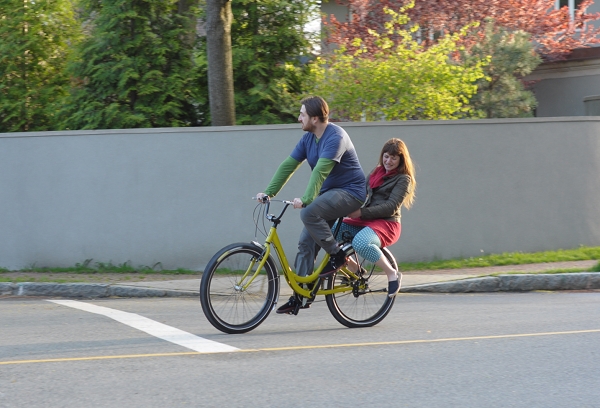
A month ago, I received a bicycle from the Canadian manufacturer
Urbana, to test ride and review. When the offer was initially made, I visited
Urbana's website and was both confused and intrigued. Did they not see that I liked classic bicycles and not modern monstrosities? Did they realise the risk they were taking asking me to review this thing? Still, even then I was aware that this wasn't some generic comfort bike, but a unique design with a distinct look and unusual geometry. The manufacturer insisted that I'd like it once I tried it, and my curiosity was piqued.
If you've been reading this blog for the past month, you know the result: I ended up riding the
Urbana far more than I had intended... to the annoyance of some readers who found it not sufficiently "lovely" to grace this website. But to those readers I say: Come on, open your mind. Though not "pretty" in the classic sense, the
Urbana is aesthetically harmonious, well-designed and comfortable - which in my book is lovely indeed. The neon yellow was an accidental choice on my part: It was described as "olive" and looked army green on the website. But everything else about this bike I like. In fact, had I gotten it in black I would have had a problem parting with it - so perhaps the neon colour is a blessing in disguise.
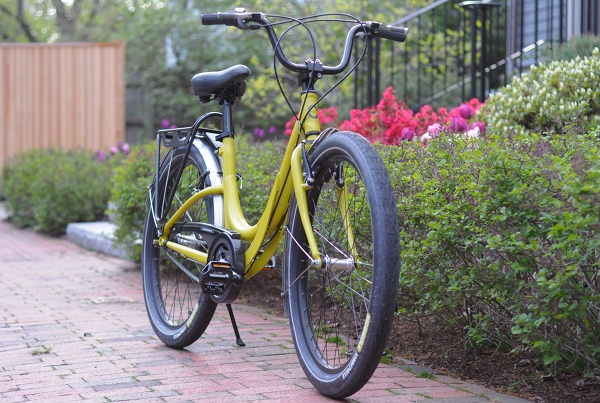
So, what kind of bike is the
Urbana? Technically speaking, it is a hybrid between a mountain bike, a BMX bike, and a Dutch transport bike. The mountain bike legacy comes from the downhill MTB designer Jerome Roy, in the form of reinforced frame and fork construction with wide 26" tires. The BMX attribute is in the handlebar setup and in the squat stature.
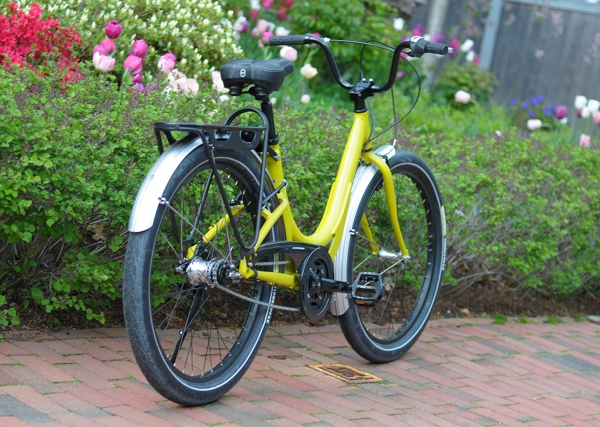
The Dutch aspect is in the relaxed angles, deep U-frame, fenders, and heavy-duty rear rack. It may seem like a mish-mash of incompatible styles, but it all comes together harmoniously - and, to my eye, adorably in a "friendly little forest troll" kind of way.
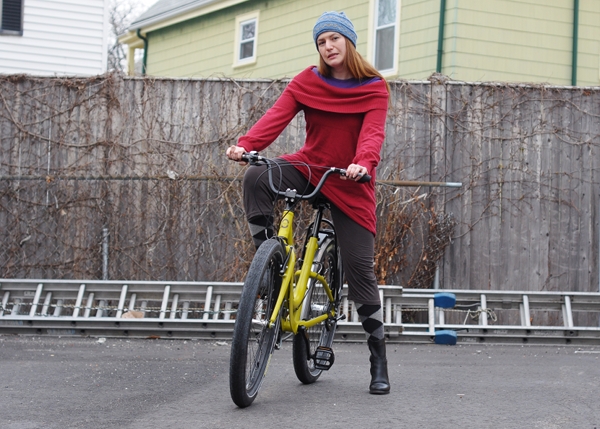
The sitting position itself feels Dutch, in the sense that the seat tube is relaxed (I would guess70° or less), and I could attain nearly full leg extension while still being able to touch the ground with a toe.
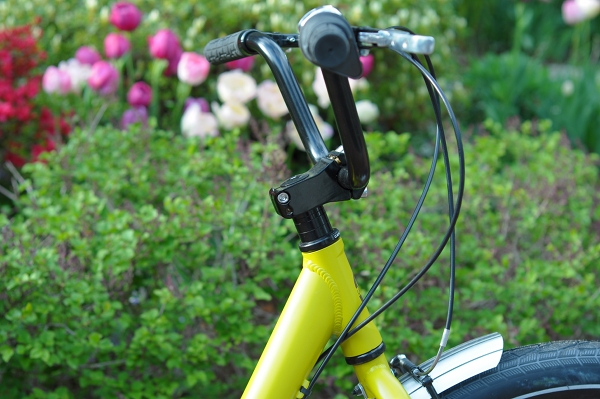
At the same time, the low BMX handlebars place the rider in a considerably more forward-leaning position, than would a Dutch bike. The threadless stem allows to easily alter the positioning of the handlebars - leaning them toward or away from the rider, depending on preferences and the person's height. I had my bars set pretty much straight and found them comfortable.
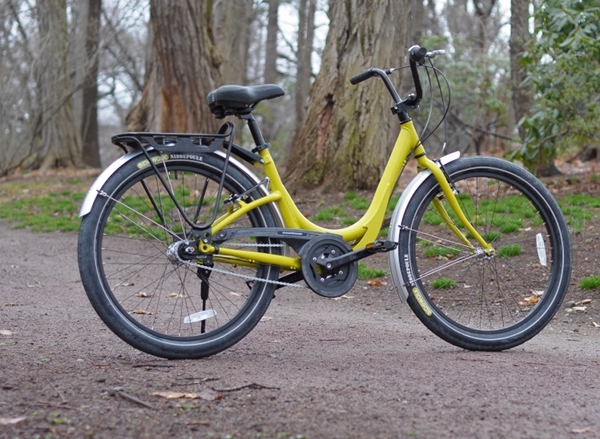
This picture shows the relaxed geometry and long wheelbase of the bike fairly accurately, as well as the saddle-handlebars positioning.The frame of the
Urbanais welded aluminum, executed in a manner that I would describe as industrial. Some readers have mentioned that the bike reminds them of "bikeshare" bicycles, but any visual similarity is superficial. The
Urbanais constructed differently and handles differently. It is a bike meant to haul serious weight and to withstand the roughest terrain, which bike-share machines are not.
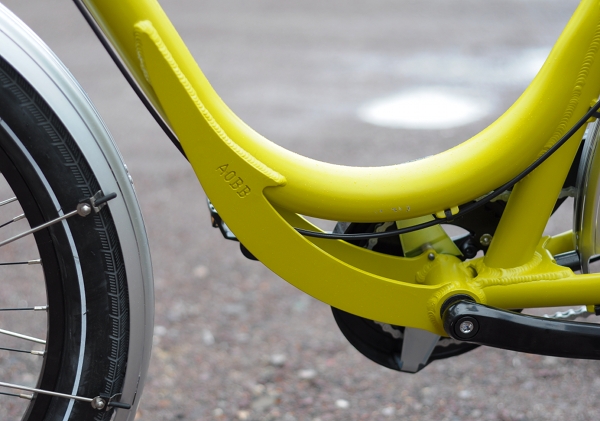
The letters carved into the frame are part of a security code for registering the bicycle (the second part of the code is located elsewhere).
Urbanahas an interesting system for registering and securing these bicycles that makes stealing them an unwise move.
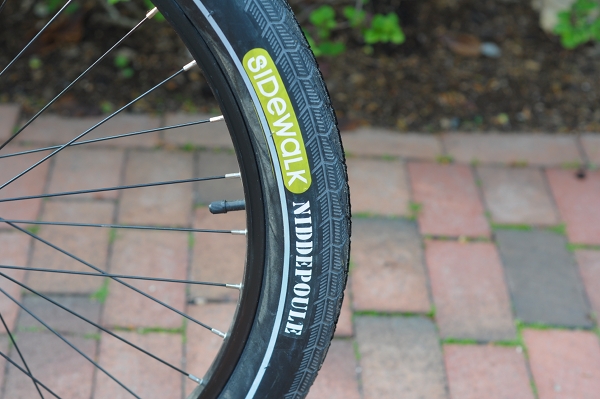
Of course, one of the main defining features of the
Urbana are its 26" x 2.6"
Niddepoule "Sidewalk" balloon tires with reflective sidewalls. They are extremely wide, extremely cushy, and roll fairly fast. I have tried most good modern fat tires at this point, and in terms of handling these feel similar to the 26"
Schwalbe Fat Franks - only wider. Potholes are not an issue.

Reviewers of the
Urbana tend to delight in how easy and fun it is to hop curbs with the tires, and of course there is that. But I feel like stressing this aspect almost trivialises them. The tires are genuinely
usefulon bad roads. There is no road shock, none at all - which is a big deal for those who find going over potholes painful. I have rolled over what I would otherwise have considered obstacles on the road and swerved to avoid. And yes, I have gone up on curbs - just not on camera.
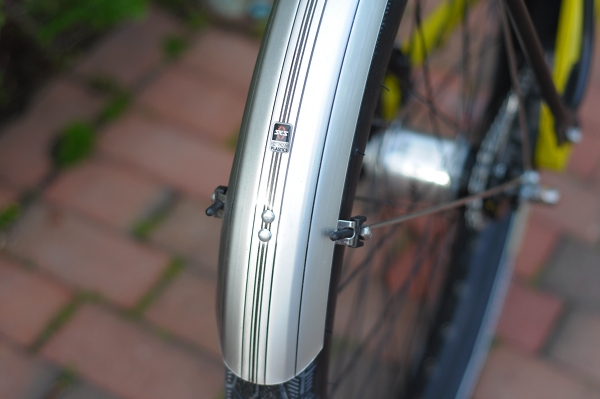 Urbana
Urbanabicycles are semi-customisable, and I requested fenders. They use
SKS fenders, which provide good coverage.
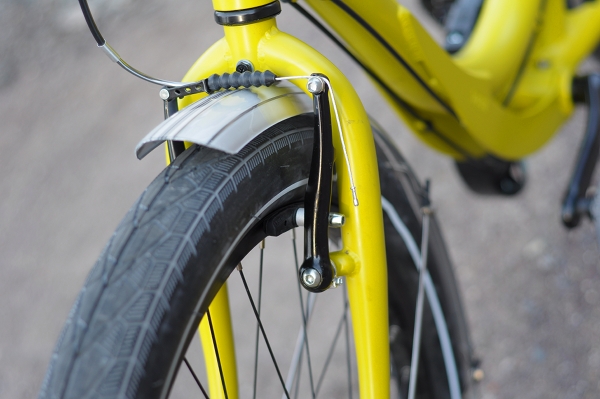
Some have complained that the front fender is too short - but while visually that is true, I did not find that I was sprayed with water from the front tire when cycling in the rain. We did find it difficult to set up the V-brakes in a way that did not interfere with the front fender. If you opt for the fenders, consider choosing disk brakes instead of the V-brakes.
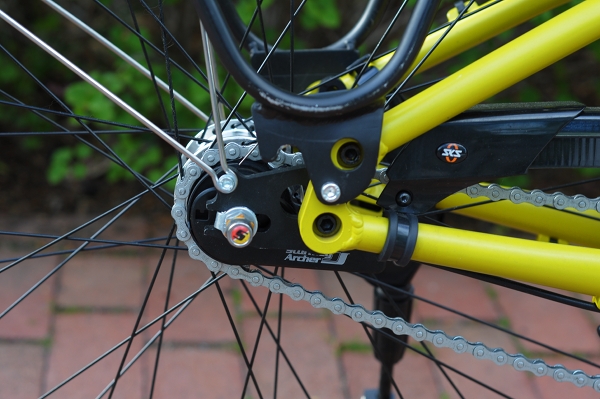
For gearing, I asked for the 3-speed option - which came with a
Sturmey Archerhub. The hub worked flawlessly and was more than sufficient for me. The gearing felt similar to that on my
Gazelle- I stayed mostly in second gear. Notice how the hub is connected to the (lack of?) rear dropouts. This frame construction is so different from what I am used to, that I do not even know how to describe this.

The
SAtwist shifter has a rainbow-esque look to it that I think suits the bike well. Not a whole lot of grip space next to the shifter, but more than on some other bikes I have tried. Interestingly, my hands did not hurt in the straight-in-front position these bars put me in, whereas usually I find this position unbearable as a result of nerve damage in my hands. It must be not just the hand position that bothers me, but the combination of it plus road shock. Since I experienced absolutely no road shock on this bike, the position alone did not cause discomfort. At least that is my theory as to how I was able to ride this bike, but not any other bike with the same style of handlebars.
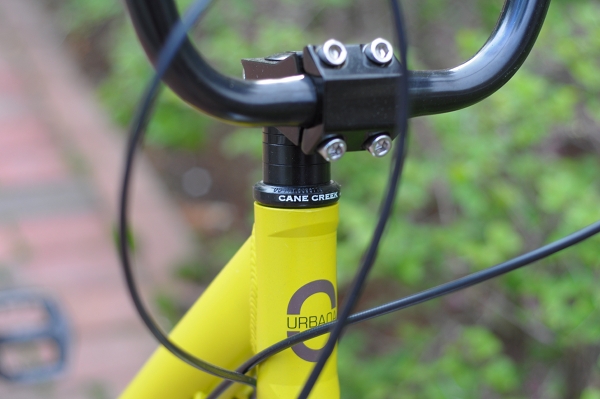
Overall, the components used on the
Urbanaare pretty good - from the
Cane Creekheadset to the
SKS fenders and chainguard. There are no flimsy, generic parts; all is solid. The Co-Habitant doesn't love the V-brakes they used, but otherwise he agrees. I thought the V-brakes were fine, though they are generally not my favourite brake type simply because they are too strong and don't modulate well. The
Urbana stopped
toowell, and I had to be careful with that.
Notably, the
Urbana is not equipped with a lighting system, which I see as its one major flaw. A dynamo lighting option would make it a fully equipped urban utility bike.

The proprietary saddle is tightly sprung and mildly padded vinyl. I found it quite comfortable for rides under 5 miles and felt no desire to change it. The Co-Habitant didn't like it, but I think that's because he is quite a bit heavier than I am and his weight made the springs over-active.
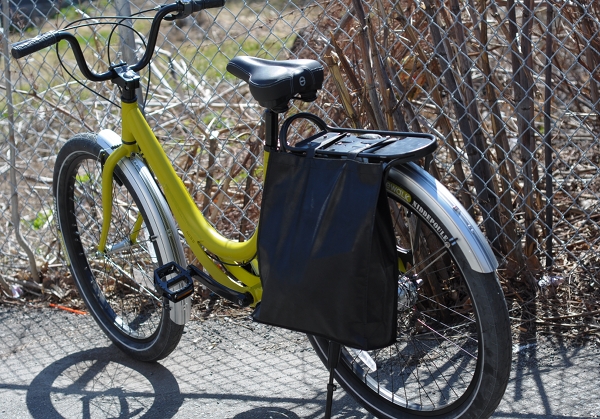
Last, but not least, there is what
Urbanacalls the Reinforced Rack (RNR). It looks fairly inconspicuous and normal as far as racks go, but is designed to withstand 160lb of dynamic weight. This includes anything from furniture, to squirming children, to - well, me.
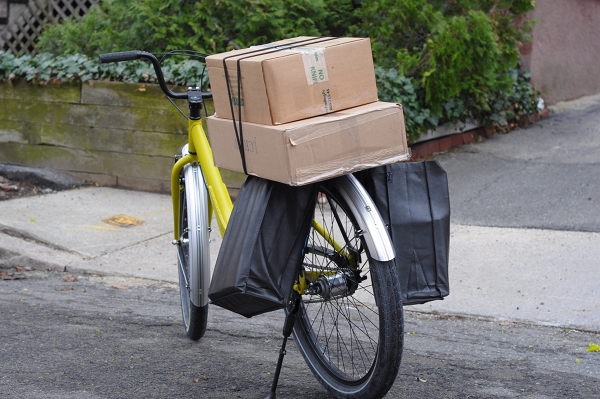
The above was a fairly easy and normal arrangement for me to set up on the
Urbana, and I wrote about it in detail here. I did not feel the weight shifting around or slowing me down while I was cycling. My
Gazelleis pretty good at carrying loads as well, but not this good.

Aside from the generous weight rating, it also helps that attaching stuff to the RNR rack is easier than to any other rack I've owned. It's a ridiculously simple design that anyone could have thought of... but didn't. Each side of the rack's platform has a carved-out section with bolts poking out undearneath, making it possible to attach virtually any bag to the rack by wrapping the handles around the bolts.
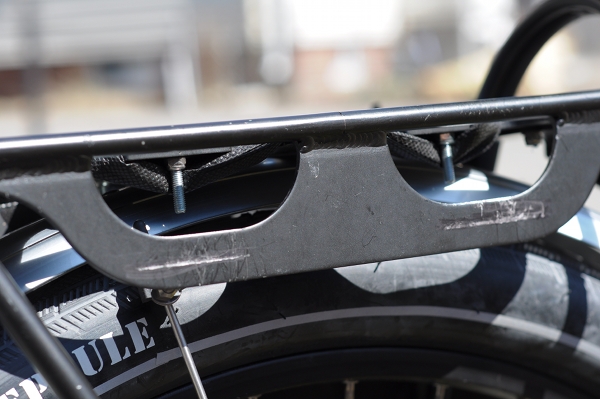
The utility and freedom afforded by this ridiculously simple design is just amazing:No need for dedicated panniers.
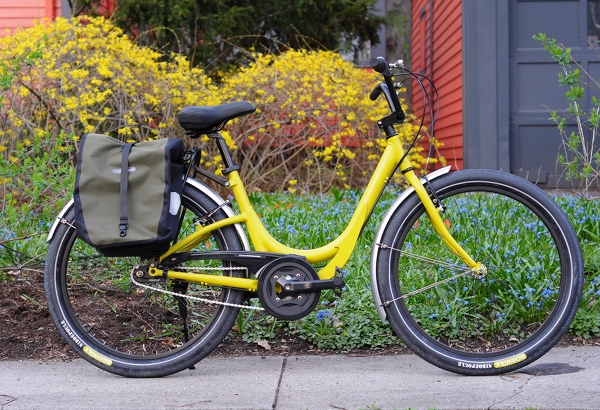
Of course, if you do with to carry panniers, it's not a problem: The rack's tubing will accommodate almost any attachment system (with the exception of fixed 3-hook systems - which I believe only
Fastrideruses). So the cyclist is really given functional freedom here. Panniers? Fine. No panniers? Also fine. The rack also has a handy built-in notch for bungee cord attachment at the bottom, which you can see here.

With its easy-to-load rack, and the durability that allowed me to keep it locked up outdoors 24/7, I was soon using the
Urbana all the time for transportation - instead of my own bikes.Before I knew it, the Co-Habitant was using it too and you can read about us sharing the bike here. All this was in no way part of my agreement with
Urbana, but entirely a product of how convenient the darn bike was to use. In the end, we end up using what's most convenient - simple as that.

The weight of the
Urbana as I had it set up was roughly 42lb. There is one particular section on the seat tube by which it is very easy to pick the bike up, making the weight totally manageable. To pick it up any other way is uncomfortable. But best of all, is to park it outdoors. I kept it locked up in the back of the house for the entire month it was in my possession, and it weathered this just fine.
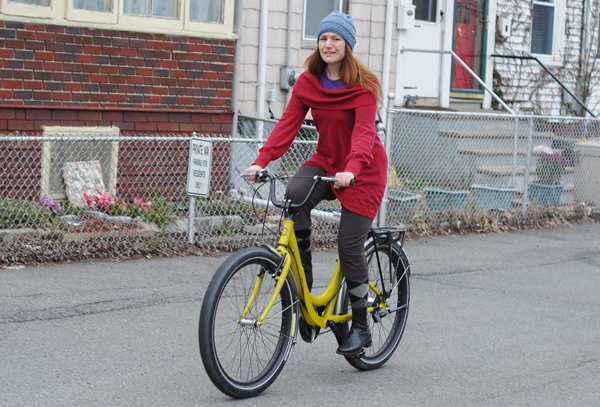
The ride quality feels more than anything like that of a good mountain bike... fitted with unusually fat, fast tires. Maybe because I rode a mountain bike in high school, the experience of riding the
Urbanamade me feel young and "bad-ass" again, which I enjoyed. Gosh, if someone gave me this bike when I was 16 years old and riding this, I would have been in heaven! Aside from the fun ride, this is probably the most stable bike I have tried thus far, all things considered. The responsiveness is decent, but obviously not roadish. Maybe half way between a mountain bike and Dutch bike. Acceleration is surprisingly good, and going uphill was similar to my
Gazelle (i.e. good enough for my terrain). If you have ever tried a
Retrovelo, its ride quality comes the closest to the
Urbana than anything else I've tried - save for the posture and hand positioning.
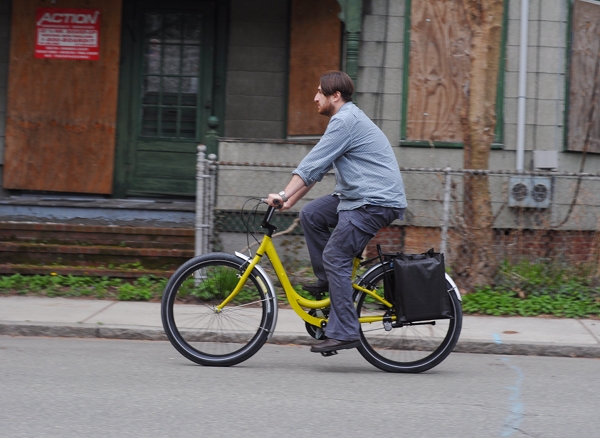
Co-Habitant on the
Urbana, with grocery bags.
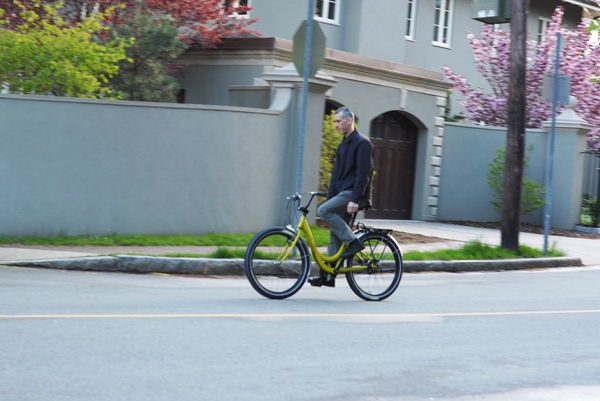
Our neighbour Somervillain on the
Urbana, riding no hands.
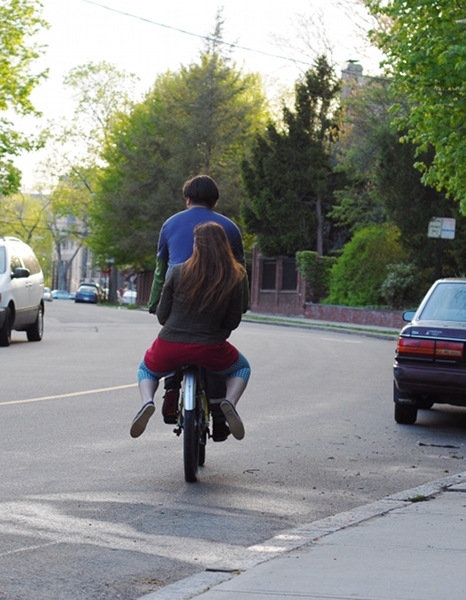
And the two of us together again. Can't say that I particularly enjoy riding on the rear rack (I like to pedal, not to be carted around), but it is definitely doable and the bike remains stable. We went to the grocery store this way once when we didn't feel like taking separate bikes, and it was fine. I screamed when he tried to hop a curb with me onthe bike, but you can hardly blame me for that.
Overall, I do prefer the ride quality of traditional, upright loop-frame bicycles to the
Urbana, simply because of the more comfortable hand positioning and the upright posture. Over long distances, I begin to find the MTB posture tiring - whereas on my traditional upright bicyclesI can keep going for 30 miles. However, the utility and convenience of the
Urbanamade me prefer it for short-distance trips - especially when carrying anything of significance on the bike. Had the bike been equipped with lighting, its utility would have been truly remarkable, but the lack of lights made it only usable during daylight hours.
The US retail price of the
Urbana will be around $1,000-1,370 - depending on how it is equipped. I suspect that the market will find that price range too expensive for this particular bike, but I could be wrong. Would I buy it for myself? Possibly - especially as a winter bike and dedicated "cargo chariot" that I would share with the Co-Habitant. I would get it in black, and I would want them to knock several hundred off the price. That is my honest feedback.
More than anything, the
Urbana challenged my priorities - an experience that will have a long-lasting effect on my design sensibilities. I appreciate the opportunity to review this product and wish
Urbana the best of luck.
 Happy Fourth of July! Remember firearms are allowed in the park, but fireworks are not.
Happy Fourth of July! Remember firearms are allowed in the park, but fireworks are not.














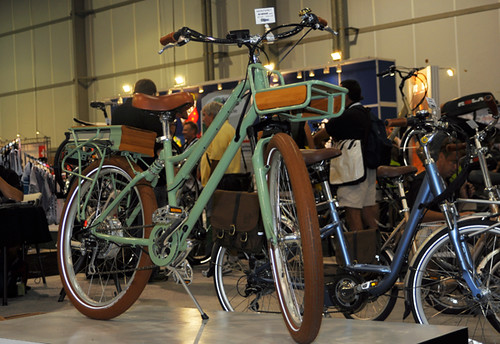
 It's been a bit since I took pictures while we are driving somewhere, so I decided to do it yesterday while we drove up to Nags Head. I am so in love with the scenery here. When Austin was here with us, he wasn't impressed in the least with it. BORING is what he said. I can see why it would seem kind of monotonous to some. I never tire of it though.
It's been a bit since I took pictures while we are driving somewhere, so I decided to do it yesterday while we drove up to Nags Head. I am so in love with the scenery here. When Austin was here with us, he wasn't impressed in the least with it. BORING is what he said. I can see why it would seem kind of monotonous to some. I never tire of it though. I normally hate driving with the windows down. I didn't even like riding with the top down when Nathan had a convertible. Here, I want to not only roll the windows down, I want to hang my head out the window like a carefree dog.
I normally hate driving with the windows down. I didn't even like riding with the top down when Nathan had a convertible. Here, I want to not only roll the windows down, I want to hang my head out the window like a carefree dog. It's just soothing to me for some reason.
It's just soothing to me for some reason. There was quite a bit of smoke up that way, and it really triggered my allergies. Still, it was worth it. Once we arrived in Nags Head, we did a bit of shopping and scored some greatly needed beach shoes and new shirts for a great price. As we were leaving the store, we ran into Jack and Ruth, a couple that I work with. We ended up eating dinner with them at the Mexican restaurant Azteca and it was very good. It was a nice bonus to have good company too.
There was quite a bit of smoke up that way, and it really triggered my allergies. Still, it was worth it. Once we arrived in Nags Head, we did a bit of shopping and scored some greatly needed beach shoes and new shirts for a great price. As we were leaving the store, we ran into Jack and Ruth, a couple that I work with. We ended up eating dinner with them at the Mexican restaurant Azteca and it was very good. It was a nice bonus to have good company too.





























